With the Mayor’s Office of Housing and Community Development having formally determined that the proposed development of 178 affordable apartments to rise up to six stories in height across the half-block-plus parking lot parcel at 88 Broadway would not have a significant effect on the environment, the development team is now planning to break ground this August.
And if the ground is broken in August, the development, which includes 53 units of senior housing in a building to rise up to six stories in height on the eastern spur of the site fronting (735) Davis Street, should be ready for occupancy in March 2020 with the construction workers “expected to park on the street or in nearby garages, or to use transit” as the entire site will be under construction at the same time.
That being said, an appeal of the City’s environmental determination for the project has been filed by a distant neighbor in Telegraph Hill, as we first reported last month. And if the aforementioned determination was to be overturned, and a full Environmental Impact Report (EIR) was required, it could add a year (or two) to the development’s timeline, even with the streamlined approval process for affordable housing projects now in place.
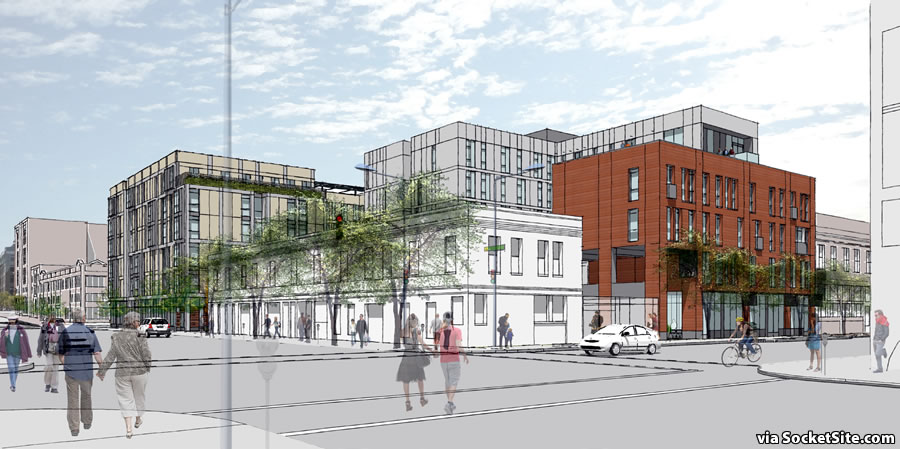
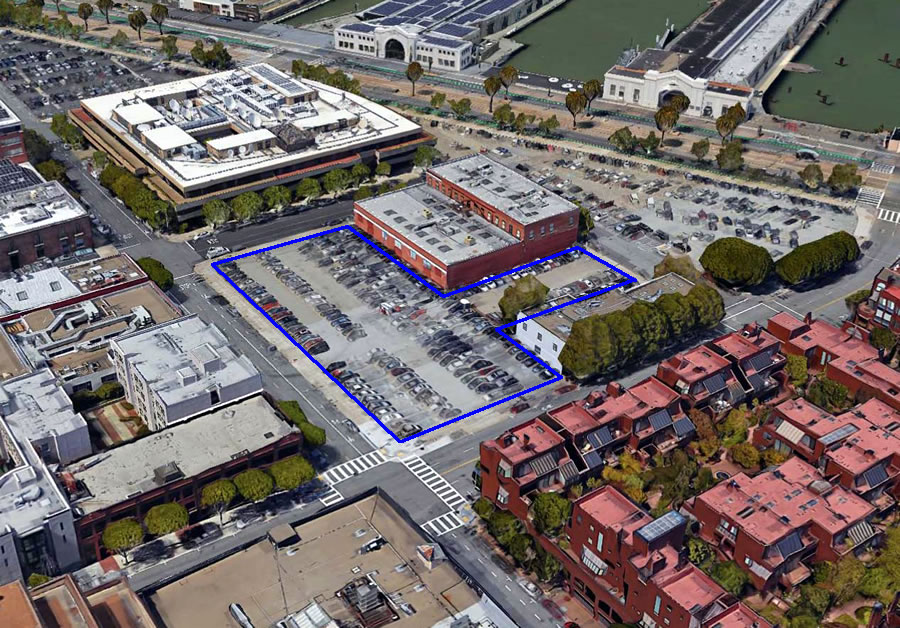
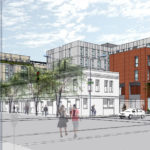
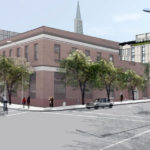
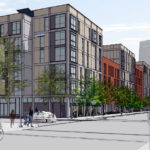
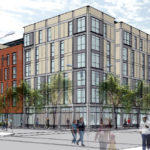
How can a project as low scaled, well designed and much needed possibly be “contentious”? Except to the elitist Telegraph Hill Neighbors.
Shame on them. I hope it gets built soon.
Contentious because it is being contested by neighbors? Same as many developments in the Mission are contested – doesn’t mean that the author is siding with anybody.
What I would like to know is if the appellant had their filing fee successfully waived or not?
Why are we putting affordable housing on some of the most expensive and desirable property in San Francisco?
Shouldn’t the SF Port Authority instead be selling this property for its highest and best use and using the proceeds to help its billions of dollars in unfunded maintenance and upkeep budget on its existing properties?
Because…San Francisco
Putting affordable housing in the middle of nowhere helps no one. In fact, there’s plenty of affordable housing all over flyover country.
They would fight that as well. Otherwise we’d have 8 Washington built already.
But, but… SAVE THE WATERFRONT!!! Remember 8 Washington? Well, this project is just as close, etc., etc., etc. Face it, THD has a stranglehold on all they survey. I hope the whole goddamn hill fractures and crumbles, burying those selfish SOB’s with it.
This does seem to be the same as the Save the Waterfront – just aimed at a different category of resident.
I have lived inline straight above where this project will be built so I can speak very knowledgeably to the realities – Namely – much worse residential parking for established neighbors. We already have crises level on our hill because of the business parkers parking up Vallejo & Montgomery. We need the parking in that lot to remain (in fact a double-decker parking facility (although not pretty (unless done well)). My neighbors include a large percentage of over 70 years old and they already cannot park near their homes of 30+ years. We also have a growing number of residents with strollers (on one of the steepest inclines in the city). Oddly, there is no handicap parking, or loading/unloading zones on “the steeps.”
Between the explosion of nearby business, frequent filming, and construction – the residents of the original construction are struggling DO NOT add hundreds more residents (and their vistors) and take away the large business and tourist parking. There are NO bus lines on our hill (nor will there probably ever be because the nascent tourist bus or delivery truck gets stuck on the crest and tight corners and narrow streets annually.
It is not just “pie in the sky” but actually idiotic to apply the thinking of public transportation enthusiasts to this area. You will effectively trap our youngest and eldest residents if you load more population stress on this area. Please, I beg you, locate large housing initiatives elsewhere!! (or better yet – break them into very small ones – to which probably all neighborhoods would have less objection).
The locals better get used to the idea, because this area along with virtually the entirety of SF will be upzoned to between 45 and 85 feet, without parking minimums or design controls, under SB-827.
As it should be. This entire city needs to become 45-85 feet to keep up with demand. Parking minimums will become parking maximums as an outdated focus on driving vehicles makes way for transit, bicycling, ride share and eventually self-driving fleets.
Great! All for it.
Unless we are willing to fund infrastructure, and elect a city government that is actually capable of executing infrastructure projects, and citizens who are willing to allow these projects to proceed in their communities, simply up-zoning will make the city unlivable. With the right planning, transit, power, water, sewer, etc, upzoning is positive. AND, we can not push it all back to the developers. There is just too much to do.
Expecting an infrastructure build-out *before* upzoning puts the cart before the horse. How will the city plan and prioritize infrastructure before anyone knows exactly where and what developers will build? Spending on infrastructure before demand is realized risks a huge waste of resources.
As an excessively democratic institution, it’s unreasonable to expect SF politicians to plan ahead. They’ll respond to the loudest, best-funded voices in the room. Once we upzone and build, voices for infrastructure investment will get louder as a consequence of the larger constituency for it.
The problem is that building homes and offices takes years, but building infrastructure takes decades. The commute for many people is nearly unbearable right now and it’s going to get much worse. Most people here won’t see any improvement in infrastructure in their working lifetimes.
Frankly I just don’t understand the ‘growth at all costs’ approach. What’s the point? How about prioritizing quality of life instead? The meaning of life is not GDP growth.
Absolutely agreed that our government should br prioritizing quality of life instead of endless growth. Other places seem to do so successfully – we should be able to do so too….
We have crappy public services, and it seems our land use decisions and policies largely exist to line the pockets of the few. Other places do a better job with urban affairs – it’s not rocket science.
Unless you have ideas on how to arrest population growth we need to figure out how to accommodate the future generation. Sprawl is not the answer anymore.
This is still a free country and people will move where they will. The only way to keep people out is to make it cost prohibitive. Unfortunately that has the effect of pushing out people who can’t otherwise afford to stay.
We have the economy and the jobs. We have the desirable climate. We have the cachet of being “San Francisco,” People are going to move here and as much as you might wish it to be true the only choice we have is to either build to accomodate or force people of lesser means out.
Streetcar lines were built before subdivisions in the early 1900s… subways and elevated trains were built into northern Manhattan and the Bronx long before those areas were densified. Of course planners can lay out infrastructure and build it out before density goes in – and that makes the most sense, as building the infrastructure first causes the least disruption.
Elevateds, yes, subways, probably not – at least not for Manhattan…it was 1904, after all – but this was actually the subject of battling editorial philosophies in the NYC papers: the NYT, I believe, wanted them built after areas were developed, while the Hearst papers wanted them built in advance. (I believe a compromise of sorts was worked out: they were planned to be in advance, but construction was so slow the areas were actually developed by the time they were finished 🙂 )
But also (and I’d meant to mention) – the streetcar lines in the East Bay (which became Telegraph Ave., Shattuck Ave., etc.).
Streetcar – and even cable-car – lines were often subsidized by developers as an inducement to get people to buy lots in what would be otherwise inaccessible areas. That continued – somewhat – in the motor era with bus lines, but faded as car ownership became more common.
In Oakland, many of the early lines – I believe Grove St. was the first line electrified – were built to connect Oakland and Berkeley, and thus really more point-to-point systems; tho of course that had the salutary effect of allowing for developing the properties along the line. The Piedmont Cable lines, I will grant you, seem to have followed the classic pre-development model.
And now, as the Control Voice always likes to say: back to the already developed, and infrastructure-heavy 700 block of Davis.
Please, please, please FINALLY rid the Embarcadero of all parking lots.
From the renderings, it looks like the eastern “spur” is only 4 stories (at least, not counting the set-back levels above), with the full 6 stories on the western side. (see, e.g., drawing with the red bi-level building in the foreground.)
While the eastern spur steps down to four stories along Davis, the majority of the 735 Davis Street building (which includes the light gray in the rendering above) rises up to six stories in height.
What the contention is really about is that Chinatown Neighborhood Development Corp, a non-profit, lost the competition to build the affordable housing, fair and square, and it was awarded to another non-profit, Bridge Housing. CNDC thinks it “owns” the neighborhood, and got their flunky Aaron Peskin to stir up a hornets nest.
Aaron has proposed putting a Navigation Center there, so permanently affordable housing would be replaced by temporary affordable housing. And of course, the Telegraph Hill Dwellers end game is to be sure nothing ever gets built there, just like 8 Washington.
Senator Scott Wiener and Mr. Ting introduced a new bill last week encouraging developers to build bigger, better and above the aforementioned 45-85 feet. In fact, we should absolutely allow these heights to soar above 400 feet – and why not? Almost all areas in this City are within a mile radius of a [major] transit hub.
Telegraph Hill is prime for [a] high-rise. We also need to build massive structures in the Mission, Castro and Potrero Hill. Their infrastructure is robust enough to sustain 300 – 400 foot lower-middle income dwellings. The 8 Washington whining has faded. Water views are not protected anymore. These are anemic arguments against affordable housing. We also need more clinics.
In fact, SB 827 was initially restricted to a one-mile radius of a bus stop to develop dwellings above and beyond existing height limits. I have heard the revised version will actually expand the radius. It should. Even NIMBY ‘neighborhoods’ like Noe Valley and the Marina are connected by ‘high quality transit.’ Any ‘hood that has an intersection of two or more active transit routes, regardless of how quaint, is fair game.
The Supervisors, Planning Department, developers and intelligent progressives are all on the same page this time. Why would we waste our time limiting all of this desperately needed upzoning and affordable housing to the Central Soma Plan – the main vein along 4th and south of Howard? I lived in the Mission about 10 years ago and it has multiple Muni lines, buses, Bart, etc. They need housing, so build, build, build. Folks, it is time to ring in the new year and upzone all of San Francisco – which is a CITY, not a suburb. Move to Marin if you don’t appreciate smart, effective urban development.
Folks, it is time to embrace the new HIGH times. Nobody’s backyard is exempt.
Wanted to chime in on this conversation to share the perspective of a nearby neighborhood group, North Beach Neighbors, that I’m the President of. Here is the letter that we just shared with Acting Mayor London Breed and District Supervisor Aaron Peskin:
Dear Acting Mayor London Breed and Supervisor Aaron Peskin,
North Beach Neighbors (NBN) is a San Francisco non-profit organization comprised of more than 100 North Beach residents, local businesses, and civic leaders. Since 1981, we have advocated on behalf of neighbors to create a vibrant, inclusive neighborhood.
With these goals in mind, we write to you today to strongly support the expedient construction of the much needed 88 Broadway Affordable Housing project without any delay. We were impressed by the community outreach by City departments in the conception of the project, followed by the numerous meetings held with the developers and architects of the project. Over the past years we have seen broad community input and concerns addressed which resulted in a mature building design that is scheduled to begin construction this year.
However, NBN is concerned that recently the 88 Broadway site has been considered for a Navigation Center. While we support locating a Navigation Center in District 3, we believe an alternative location must be found that does not threaten to delay the start of an all-too-important affordable housing project.
North Beach will be a stronger, more inclusive community if we can both build a Navigation Center and follow through on the promise of nearly 178 affordable family and senior housing units including 20 for the formerly homeless. We must choose to do both, and we must move forward with urgency.
Please see that the 88 Broadway Affordable Housing project moves forward to provide the much needed housing that our community needs, and that a robust community outreach process for the Navigation Center is undertaken.
Danny Sauter
President
thanks danny. we need more groups like yours
UPDATE: Planning Recommends Rejection of Affordable Housing Appeal